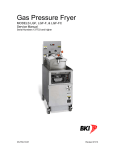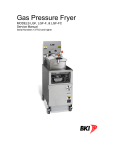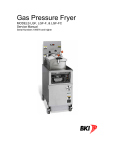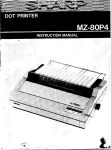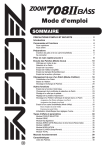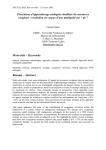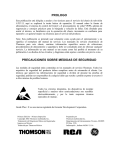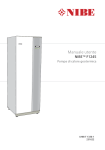Download Computer-assisted comprehension of texts
Transcript
US008126700B2
(12) United States Patent
(10) Patent N0.:
Fasciani et al.
(54)
(45) Date of Patent:
Feb. 28, 2012
COMPUTER-ASSISTED COMPREHENSION
7,107,204 B1 *
9/2006 Liu et a1. ......................... .. 704/2
01: TEXTS
7,664,629 B2 *
2/2010 Dymetrnan et al.
.
(75)
US 8,126,700 B2
.
.
.
.
Inventors: Dante Fasclanl, Pagan1ca (IT); (;.lllll0.
5/2002
Nakao .............. ..
2003/0046057 A1 *
3/2003
Okunishi et al.
704/1
2003/0149557 A1,.
8/2003 COX et a1‘ """ “
704/2
Maltese, Rome (IT); Masslmo Vlllanl,
2003/0236659 A1* 12/2003 Castellanos .
Rome (IT)
2004/0083224 A1 *
2004/0138872
(73)
Assignee: International Business Machines
Corporation’ Armonk’ NY (Us)
(*)
Notice:
704/4
2002/0052730 A1 *
A1 *
2006/0217961 A1:
2007/0033002 A1
704/10
704/4
4/2004 Yoshida ..
.. 707/100
7/2004
. . . ..
Nir
... ... ...
704/10
9/2006 Masulchl et al' ~~~~ ~~
704/3
2/2007 Dymetrnan et al. ............ .. 704/5
OTHER PUBLICATIONS
Subject to any disclaimer, the term of this
patent is extended or adjusted under 3 5
Li et al. “Using bilingual Web data to mine and rank translatons,”
U_S_C_ 1540;) by 1187 days_
IEEE intelligent Systems, pp. 54-59, Published: Jul. 2003*
Zheng, “StarDict manual”, version 2.4.2, [online], http://stardict.
sourceforgenet. User manual of StarDict, afree electronic dictionary
software, published 2003, retrieved from http://WWWarchiVeorg,
archiving datei Jan 15, 2005*
(21)
App1_ NQ_; 11/692,388
(22)
Filed:
Mar. 28, 2007
*
(65)
.
Prior Publication Data
US 2007/0233461 A1
_
(30)
_
Oct. 4, 2007
Primary Examiner * James S. Wozniak
_
Assistant Examiner * Jialong He
_
_
Fmlg" APPllcatl0n Pmrlty Data
Mar. 29, 2006
(74) Attorney, A gent, or Firm 4 DeLiZiO Gilliam, PLLC
(EP) ................................... .. 06111871
(51) Int_ CL
G06]? 1 7/28
.
ened by exammer
(57)
ABSTRACT
A solution is proposed for the data-handling system-assisted
comprehension of texts (particularly, When they are Written in
(200601)
(52)
us. Cl. ........ .. 704/4; 704/2; 704/3; 704/5; 434/157
a foreign language) For this Purpose’ a dif?culty index is
(58)
Field of Classi?cation Search
associated With each known Word (for example, according to
70 4 Milo,
""""""
s
4/157i178’
its frequency of use in standard texts). The Words of a current
1- 1?l f
1 1
11 11 - 1
.
ee app lea Ion e or Comp e e Seam 15 Dry
(56)
document 0 P ened usin g the data-handlin g s Y stem are sorted
according to their dif?culty indexes. The Words having the
References Cited
dif?culty indexes higher than a threshold value (for example,
based on the skill of a reader) are selected as dif?cult. A
translation of each di?icult Word is then extracted from a
dictionary; this translation
is, displayed close to each occur
,
US. PATENT DOCUMENTS
5,5l7,409 A
*
5/l996
OZaWa et al.
................... .. 704/3
6,272,456 B1 4
8/2001
de Campos ' ' ' ' ' '
' ' ' ' “ 704/8
6,393,389 B1 *
5/2002
Chanod et al.
.... .. 704/7
6,735,559 B1 *
5/2004 Takazawa ....................... .. 704/7
\ALLoad
rence of the correspondmg dlf?cult Word.
16 Claims, 5 Drawing Sheets
530
510 X
F 500
Documents
Sample
documents
A2.Parse
505
'
A4.Open
A3.Classify
Analyzer
515
;
A5.Update
_
A7.Translate
'
AIOJncrease : Dictionary
Al 1 .Insert
A9vRequest
Input
drive
535
525
View“
A14.Decre1ase ‘
Al3.Dese1ect
'
A8.Dis'play
A12.Add
A16.De1ete
A6.Select
-
value
A15.Removei
1
540
i ‘
i ‘
/
Monitor
520/
.
W
Threshold
D‘f? ult
as.
x 545
US. Patent
Feb. 28, 2012
Sheet 1 015
US 8,126,700 B2
F
115
105
FIG. 1
100
US. Patent
Feb. 28, 2012
Sheet 2 of5
US 8,126,700 B2
220
215
n
. . . . . . . . .. ' TRANSLATION
....WORD(1_)
VlOBD
lVO_R[l('3)
(2)
WORD(4).
._ _ _ _ _ _ _l
....WORD(5)WORD(1)WORD(6)WORD(3)....
215
/
....WORD(7) WORD(3) WORD(5) WORD(2). j
| TRANSLATION (2) |
I-
_
_
_
_
_
_
....WORD(8) WORD(3) WORD(7) WORD(5).
....WORD(3)
r —
WORD(9)
- - WORD(2)
- - -WORD(1
1
).
I TRANSLAT|ON(9) I0 215
....WORD(8) WORD(9) WORD(10) WORD(5).
FIG. 2
210
US. Patent
Feb. 28, 2012
Sheet 3 of5
US 8,126,700 B2
A
215
. . . . . . . . ..
1i
)A\
....WORD(1) wO_RD(_2)l\]/CLR[A3)_|WORD(4)....
205
LTRANSLATION (2) |
....WORD(5) WORD(1) WORD(6) WORD(3).... 215
310 '“ /
/
K
....WORD(7) WORD(3) WORD(5) WORD(2).... ,7
| TRANSLATION (2) |
I-
_
_
_
_
_
_
....WORD(8) WORD(3) WORD(7) WORDwk.
\
2\
....vvoRD(3lvv_0R_D@ vlogmz) WORD(1)....
305
LTRANSLATION (9) kw 215
....WORD(8) WORD(9) WORD(10) WORD(5)....
FIG. 3A
215
. . . . . . . . ..
A
4/
;A\\
....WoRD(Qvv_oR_D(2) )LQIO_RD_(|3) WORD(4). . ..
2 05
LTRANSLATION(2) |
....WORD(5)WORD(1)WORD(6)WORD(3)....
210'? /
215
/
....WORD(7) WORD(3) WORD(5) WORD(2). . ..
l
—
—
—
—
—
—
—l
,7
JEMLS'fTLO'LQLI 2/15
....WORD(8) WORD(3) WORD(7) WORD(5). . ..
()
LTRANSLATION (5)?
....WORD(3_) VlOBDQ)lVClQEl€2) WORD(1). . ..
| TRANSLATION (9) ry 215
I-
_
_
_
_
_
_
....WORD(8) WORD(9) WORD(10) WORD(5). . ..
|
_
_
_
_
_
_
_'
\
Jfhis??P'iwlw 215
V
US. Patent
Feb. 28, 2012
Sheet 4 of5
US 8,126,700 B2
215
/
........ ..
0
....vvoRDQ )lVClRllZL/VQRDQ) WORD(4). . ..
LTEME'LFPNJZLI 04/305
....WORD(5) WORD(1) WORD(6) WORD(3). . ..
2 10
....WORD(7) WORD(3) WORD(5) WORD(2)
l
,
.JEMLSE‘TLONJZLW 215
....WORD(8) WORD(3) WORD(7) WORD(5). . ..
....WORD(3LW_OR_D(@VLOBD(2) WORD(1)....
LTRANSLATION (9) if 215
....WORD(8) WORD(9) WORD(10) WORD(5). . ..
FIG. 4A
120
....WORD(1) WORD(2) WORD(3) WORD(4). . ..
\205
,b 3 05
....WORD(5) WORD(1) WORD(6) WORD(3)....
....WORD(7) WORD(3) WORD(5) WORD(2). . ..
....WORD(8) WORD(3) WORD(7) WORD(5). . ..
....WORD(3_) vlogoglvcgggz) WORD(1)....
| TRANSLATION (9) by 215
I-
_
_
_
_
_
_
....WORD(8) WORD(9) WORD(10) WORD(5)....
FIG. 4B
210 4
US. Patent
Feb. 28, 2012
Sheet 5 of5
US 8,126,700 B2
.UEm
mmm
on?36»
20:35
US 8,126,700 B2
1
2
COMPUTER-ASSISTED COMPREHENSION
OF TEXTS
Therefore, the automatic translation tools are at best useful
to provide the raW meaning of the argument of the (original)
text. In any case, they are completely unable to convey the
complete understanding of the text. The solution is then
untenable in most practical situations (for example, When an
accurate comprehension of the text is required).
CROSS-REFERENCE TO RELATED
APPLICATIONS AND CLAIM OF PRIORITY
This application claims the bene?t of priority of French
Patent Application No. 06111871.7 ?led on Mar. 29, 2006,
and entitled “METHOD, SYSTEM AND COMPUTER
BRIEF SUMMARY
PROGRAM FOR COMPUTER-ASSISTED COMPRE
A system, method, and computer program product for
facilitating computer-assisted comprehension of texts by a
HENSION OF TEXTS” hereby incorporated by reference
user of a data processing system are disclosed. In one embodi
herein for all purposes.
ment, a method is provided Which comprises providing a
digital representation of a text, the text including at least one
BACKGROUND
occurrence of each one of a plurality of expressions, associ
ating each expression With a dif?culty index indicative of a
1. Technical Field
Embodiments of the present invention relate to the infor
mation technology ?eld. More speci?cally, such embodi
ments of the invention relate to computer-assisted compre
hension of texts by a user of a data processing system.
20
outputting at least part of the text With an indication of the
2. Description of Related Art
explanation of each corresponding selected expression.
The comprehension of texts is not alWays an easy task. For
example, this may be particularly dif?cult for complex texts,
especially When they relate to very specialist ?elds (such as
corresponding comprehension dif?culty, selecting a set of the
expressions according to a comparison of the corresponding
dif?culty indexes With a threshold value, associating each
selected expression With a corresponding explanation, and
BRIEF DESCRIPTION OF THE DRAWINGS
25
technical papers). The problem is more acute When the text is
Written in a foreign language (Which a reader of the text does
features and advantages thereof, Will be best understood With
not knoW perfectly).
reference to the folloWing detailed description, given purely
In order to mitigate this problem, a number of tools are
available to assist the reader in translating the text into his/her
native language. For example, on-line dictionaries are com
monly used to look up the Words that are not known to the
Embodiments of the present invention, as Well as further
by Way of a nonrestrictive indication, to be read in conjunc
30
FIG. 1 is a pictorial representation of a computer that canbe
used to practice the solution according to an embodiment of
reader. HoWever, the operation of retrieving the translation of
the invention;
FIGS. 2, 311-319 and 411-419 illustrate exemplary applications
each desired Word from the dictionary is very time consum
ing. Moreover, the reader must continually interrupt the read
ing of the text; therefore, s/he is diverted by those repeated
35
FIG. 5 is a collaboration diagram representing the roles of
different softWare modules implementing the solution
according to an embodiment of the invention.
40
DETAILED DESCRIPTION OF AN
ILLUSTRATIVE EMBODIMENT
number of different algorithms. For example, the simplest
solution consists of replacing each Word of the text With its
of the solution according to different embodiments of the
invention; and
changes (betWeen the text and the dictionary). This has a
detrimental impact on the concentration of the reader, and
then on the comprehension of the text.
Automatic translation tools are also knoWn in the art. Those
tools are based on softWare programs, Which translate the text
in a different language Without any human intervention. The
automatic translation tools available on the market exploit a
tion With the accompanying draWings, in Which:
In its general form, embodiments of the present invention
45
are based on the idea of providing an explanation of the most
dif?cult expressions only.
translation. More sophisticated solutions perform a linguistic
analysis of the text, in an attempt to decode its actual mean
Particularly, embodiments of the present invention provide
ing; for example, this cognitive process is based on lexical,
a solution as set out in the independent claims. More in detail,
embodiments of the invention propose a method for facilitat
ing computer-assisted comprehension of texts by a user of a
grammar or semantic rules. The above-mentioned linguistic
rules may be applied according to different approaches; for
example, the automatic translation tools can exploit heuristic,
50
data processing system. The method starts With the step of
providing a digital representation of a text; the text includes
statistical or analogy methods.
The same techniques are also used by services that provide
an instant translation of online texts. Those instant translation
services have become very popular in the Internet; typical
one or more occurrences of each one of a plurality of expres
55
sions (such as Words). Each expression is associated With a
dif?culty index, Which is indicative of a corresponding com
pages, e-mail, and chats (for example, in e-commerce sites).
prehension dif?culty. A set of the expressions is then selected
according to a comparison of the corresponding dif?culty
In any case, the result of the automatic translation tools
indexes With a threshold value. The method continues by
applications of the instant translation services relate to Web
associating each selected expression With a corresponding
currently available is very poor. Indeed, the meaning of any
text is heavily dependent on its context. HoWever, it is very
60
explanation. The text (or a part thereof) is noW output With an
dif?cult (if not impossible) to provide signi?cant information
indication of the explanation of each corresponding selected
about the context of the text to the automatic translation tools;
moreover, the use of this information by the automatic trans
lation tools is not trivial. As a result, the automatic translation
expression.
tools are commonly used in speci?c and Well-understood
situations only; in any case, the obtained results alWays
require a post-editing intervention by a human translator.
In one embodiment of the invention, the dif?culty index of
each expression is determined according to its frequency of
65
use. For this purpose, it is possible to calculate a percentage of
the occurrences of the expressions in prede?ned sample texts.
As a further enhancement, the frequency of use of the expres
US 8,126,700 B2
4
3
sion is updated according to the percentage of its occurrences
in the current text. Typically, the explanation of each (di?i
cult) expression is displayed close to each occurrence thereof.
A Way to further improve the solution is to alloW the selec
tion of further expressions (so as to add the corresponding
explanation to the text); at the same time, the dif?culty index
of the selected expression is increased accordingly. Con
versely, it is possible to deselect a dif?cult expression; in this
case, the dif?culty index of the deselected expression is
Moving noW to FIG. 3a, it is possible that the reader does
not understand other Words of the document 205 that have not
been translated. In this case, the reader can select one of those
Words manually; for example, it is possible to move a pointer
305 over an occurrence of the desired Word and then double
click With the mouse (such as over “Word(5)” on the ?fth roW
of the page).
In response thereto, as shoWn in FIG. 3b, the translation of
this selected Word is added to the text; as above, the transla
tion is arranged in a further box 215, Which is placed close to
each occurrence of the corresponding Word (tWo for “Word
decreased accordingly. Typically, the proposed solution ?nds
application in the translation of the dif?cult expressions in a
different language.
(5)” in the example at issue). At the same time, the dif?culty
With reference in particular to FIG. 1, a computer 100 (for
example, a PC) is illustrated. The computer 100 includes a
central unit 105, Which houses the electronic circuits control
ling its operation (such as a microprocessor and a Working
memory). The computer 100 is also provided With a hard-disk
and a drive for reading CD-ROMs 110. A monitor 115 is used
to display images on a screen 120. Operation of the computer
of the selected Word is increased, so as to have it translated
automatically at further reading of the same or any other
100 is controlled by means ofa keyboard 125 and a mouse
130, Which are connected to the central unit 105 in a conven
document. This additional feature alloWs tuning the proposed
solution to the actual skill of the reader.
With reference noW to FIG. 4a, on the contrary the reader
can already knoW the meaning of some of the Words that have
been translated. In this case, the reader can select one of the
20
215 and then double-click With the mouse (such as over
tional manner.
As shoWn in FIG. 2, in the example at issue the computer is
used to read a document 205 on the screen 120. The document
205 consists of a collection of information arranged in a
25
speci?c layout; the document 205 may include information in
different formats (such as text, draWings, pictures, graphs,
and the like). Typically, only a portion of the Whole document
205 (i.e., a page) is displayed on the screen 120 according to
its siZe. A scroll-bar 210 is used to slide the document 205
“translation(2)” on the second roW of the page).
In response thereto, as shoWn in FIG. 4b, this selected
translation is removed from the screen 120; particularly, there
are closed all the boxes containing the selected translation,
associated With the different occurrences of the correspond
ing dif?cult Word (tWo for “translation(2)” in the example at
issue). At the same time, the dif?culty of the Word associated
30
(such as vertically) for its complete reading.
Considering in particular the text of the document 205, it
With the selected translation is reduced, so as to avoid its
translation at further reading of the same or any other docu
ment. In this Way, the display of the document 205 becomes
simpler and simpler as the reader learns the meaning of its
consists of a sequence of sentences each one formed by a
Words (With the help of the proposed solution).
group of Words (With one or more occurrences of the same
Words that can be repeated in the text). Each Word “Word(i)”
corresponding translations manually; for example, it is again
possible to move the pointer 305 over the corresponding box
35
Moving to FIG. 5, the main softWare modules that run on
represents a meaningful unit (such as a noun, an adjective, a
the above-described computer are denoted as a Whole With the
verb, an adverb, and the like) of a speci?c language (for
reference 500. The information (programs and data) is typi
cally stored on the hard-disk and loaded (at least partially)
example, English).
As described in detail in the folloWing, the solution accord
ing to an embodiment of the invention is based on the obser
vation that a reader generally understands most of the text,
into the Working memory of the computer When the programs
40
disk, for example, from CD-ROM. Particularly, the ?gure
While s/he does not knoW the meaning of a feW Words only.
Therefore, it is possible to select the most dif?cult Words of
the text (for example, according to their frequency of use); an
explanation of those dif?cult Words (for example, their trans
lation in another language, such as Italian) is then displayed
close to each occurrence thereof. Particularly, in the example
at issue the di?icult Words are “Word(2)” and “Word(9)”. In
this case, their translations (denoted With “translation(2)” and
“translation(9)”, respectively) are shoWn on the screen 120;
particularly, each translation is arranged in a box 215, Which
is placed close to each occurrence of the corresponding dif
describes the static structure of the system (by means of the
corresponding modules) and its dynamic behavior (by means
of a series of exchanged messages, Which are denoted With
45
Particularly, the computer runs a vieWer 505 (for example,
50
its original form; this prevents all the problems caused by the
used to read generic documents 510 (such as letters, articles,
e-books, presentations, and the like). The reader interacts
With the vieWer 505 through (input) drives of the mouse and
the keyboard (denoted as a Whole With 515); on the other
hand, the vieWer 505 controls the monitor of the computer by
means of a corresponding drive 520.
55
operation). Therefore, the reading of the text must not be
interrupted; this has a bene?cial impact on the concentration
of the reader (and then on his/her comprehension of the text).
Moreover, the reader alWays accesses the document 205 in
intrinsic inaccuracy of the automatic translation tools.
In any case, it is emphasiZed that the solution described
above only outputs the information that is actually needed to
the reader; in other Words, the solution is substantially opaque
to the reading of the text (as far as it can be already under
stood); conversely, it intervenes only for the feW Words that
the reader is likely not to knoW.
progressive sequence numbers preceded by the letter “A”).
a Word processor, a reader, and the like). The vieWer 505 is
?cult Word (tWo for “Word(2)” and one for “Word(9)”).
The proposed solution provides the translations allegedly
required by the reader automatically (Without any manual
are running. The programs are initially installed onto the hard
60
The vieWer 505 is provided With a (plug-in) analyZer 525,
Which implements the above-described solution. For this pur
pose, the analyZer 525 accesses a set of (standard) sample
documents 530; for example, the sample documents 530 con
sist of a general-purpose encyclopedia. The analyZer 525
parses the sample documents 530 (action A2), so as to calcu
late the frequency of use of each knoWn Word de?ned in a
dictionary 535 (for example, de?ned by their percentage over
the Whole content of the sample documents 530). The fre
quency of each Word provides an estimate of its comprehen
sion dif?culty (based on the assumption that the more rarely
65
the Words are used the more dif?cult to understand they are);
a corresponding dif?culty index is set accordingly (for
example, to the complement to 100% of the above-mentioned
US 8,126,700 B2
6
5
Naturally, in order to satisfy local and speci?c require
percentage) and then associated With the Word in the dictio
nary 535 (action A3). In this Way, each reader can initialize
ments, a person skilled in the art may apply to the solution
described above many modi?cations and alterations. Particu
the dictionary 535 according to his/her speci?c requirements.
For example, it is possible to exploit different sample docu
larly, although embodiments of the present invention has been
ments 530 for a number of contexts (such as standard, tech
described With a certain degree of particularity With reference
nical, legal or prose texts).
to preferred embodiment(s) thereof, it should be understood
that various omissions, substitutions and changes in the form
Whenever the reader decides to open a speci?c document
510 (action 4), the vieWer 505 noti?es the analyZer 525
accordingly. In response thereto, the analyZer 525 likeWise
and details as Well as other embodiments are possible; more
parses the current document 510, so as to calculate the (local)
frequency of use of each knoWn Word thereof de?ned in the
over, it is expressly intended that speci?c elements and/or
method steps described in connection With any disclosed
embodiment of the invention may be incorporated in any
same dictionary 535. This information is used to update the
other embodiment as a general matter of design choice.
dif?culty indexes of these Words in the dictionary 535 (action
A5); for example, it is possible to increase or decrease each
frequency according to a percentage (such as 1-5%) of its
has a different structure or includes equivalent units (such as
local value. As a result, the proposed solution self-adapts to
thereof to reduce the accesses to the mass memory during
the actual content of the documents 510; in any case this result
is achieved With a sloW dynamic, Which ?lters out any sharp
changes due to documents 510 that are very short and/or
With any code execution entity (such as a PDA, a mobile
For example, similar considerations apply if the computer
cache memories temporarily storing the programs or parts
execution); in any case, it is possible to replace the computer
20
phone, and the like).
25
Moreover, it is expressly intended that the term Word as
used herein must not be interpreted in its strict sense; indeed,
the translation may also be applied to idioms, phrases, or
more generally to any other expressions. LikeWise, it is pos
sible to replace the dif?culty indexes With Whatever indicator
about specialist arguments.
The analyZer 525 then sorts the Words included in the
current document 51 0 according to their dif?culty indexes (as
de?ned in the dictionary 535); the Words having the dif?culty
indexes higher than a threshold value stored in a correspond
ing table 540 are selected as dif?cult. Preferably, the thresh
old value 540 can be customiZed by the reader according to
his/her skill (for example, from 20-30% for a beginner to
of hoW dif?cult (or easy) the comprehension of the Words is.
Moreover, the translation associated With each dif?cult
Word may consist of a list of Words (or more generally expres
1-2% for an expert). Those dif?cult Words are saved into a
corresponding lookup table 545 (action A6). The analyZer
sions) explaining the possible meanings of the dif?cult Word;
30
525 then translates the dif?cult Words in the table 545 (Word
in the corresponding box.
It should be readily apparent that the proposed algorithm
for calculating the dif?culty indexes according to the fre
by Word) looking up their explanation in the dictionary 535.
The translations so obtained are added to the corresponding
entries in the dif?cult Word table 545 (action A7). The vieWer
505 accesses the dif?cult Word table 545; in this Way, the
vieWer 505 can display any desired page of the current docu
ment 510 With the addition of the translation of each occur
rence of the dif?cult Words included in this page (action A8).
The same operation is repeated for any neW page of the
current document 501 that is accessed.
In a completely asynchronous manner, the reader can
select an additional Word (Which s/he does not knoWn) in the
current page; the event is noti?ed by the input drive 515 to the
35
dif?culty indexes of the Words.
Similar considerations apply if different formulas are used
to update the dif?culty indexes according to the local frequen
45
and their local values); hoWever, this feature is not strictly
necessary, and it may be omitted in some implementations of
50
page (action A12).
Conversely, the reader can select a translation (Which s/he
already knoWs) in the current page; the event is likeWise
noti?ed by the input drive 515 to the vieWer 505 (actionA13).
In response thereto, the analyZer 525 is noW instructed to
decrease the dif?culty index of the Word associated With the
55
selected translation (action 14); for example, the dif?culty
60
Way (for example, in printed form, With a text-to-speech
system, and the like).
Naturally, the procedure described above for selecting fur
ther Words and/or translations manually is merely illustrative
and must not to be interpreted in a limitative manner; for
index is brought just beloW the threshold value 540. In this
example, it is possible to provide dedicated commands for
selecting further Words and/or for deselecting dif?cult Words
(thereby obtaining the same result as selecting the corre
Way, the same Word Will not be translated any longer at a
further opening of the same or any other document 510.
505 deletes the selected translation for all the occurrences of
the proposed solution.
In a different embodiment of the invention, the translations
of all the dif?cult Words are displayed (only once) in a dedi
cated box (close to the original text); more generally, it is
possible to output the text and/or the translations in any other
tion to all the occurrences of the selected Word in the current
the corresponding Word in the current page (action A16).
cies of use of the Words in the current document, or in any
other document loaded on the computer (for example, by a
percentage of the differences betWeen the frequencies of use
(action A11); concurrently, the vieWer 505 adds the transla
Moreover, that (deselected) Word is removed from the di?i
cult Word table 545 (action A15); concurrently, the vieWer
performed by a dedicated server; in any case, nothing pre
vents providing the dictionary already completed With the
Word (action 10); for example, the dif?culty index is brought
just above the threshold value 540. In this Way, the selected
Word Will be translated automatically at a further opening of
the same or any other document 510. Moreover, the analyZer
525 inserts the selected Word With its translation (extracted
from the dictionary 535) into the dif?cult Word table 545
quency of use of the Words must not to be interpreted in a
limitative manner. For example, it is possible to exploit more
sophisticated statistical methods, to assign a ?xed minimum
value to a set of pre-selected Words, and the like.
Alternatively, the analysis of the sample documents may be
40
vieWer 505 (action A9). In response thereto, the analyZer 525
is instructed to increase the dif?culty index of the selected
it also possible to display the Whole list or a part thereof only
sponding translations).
65
LikeWise, it is possible to update the dif?culty indexes
according to different algorithms; for example, the dif?culty
indexes are increasing or decreasing by a prede?ned percent
age thereof (so as to require repeated actions to cross the
US 8,126,700 B2
8
7
threshold value). As above, an implementation Without one or
both of the above-mentioned features is Within the scope of
the invention.
adding an indication of the corresponding explanation of
the ?rst of the plurality of expressions to the output of the
Alternatively, it is possible to replace the dictionary With
any equivalent structure; for example, the translation of each
2. The method according to claim 1, Wherein associating
at least part of the text.
each expression With the dif?culty index comprises:
determining a frequency of use of the expression, and
dif?cult Word may be provided at runtime by a dedicated
service. In any case, although in the preceding description
calculating the dif?culty index according to the fre
reference has been made to the translation of documents
Written in a foreign language, the proposed solution is more
quency of use.
3. The method according to claim 2, Wherein determining
the frequency of use of the expression comprises:
generally applicable to facilitate the comprehension of What
ever text. For example, the same concepts ?nd application to
calculating a percentage of the occurrences of the expres
sion in a set of prede?ned sample texts.
explain the meaning of the most dif?cult specialist terms or
4. The method according to claim 3, Wherein associating
each expression With the dif?culty index further comprises:
acronyms of a document.
Similar considerations apply if the program (Which may be
used to implement each embodiment of the invention) is
calculating a further percentage of the occurrences of the
expression in the text, and
updating the frequency of use of the expression according
structured in a different Way, or if additional modules or
functions are provided; likeWise, the memory structures may
be of other types, or may be replaced With equivalent entities
(not necessarily consisting of physical storage media). More
20
over, the proposed solution lends itself to be implemented
With an equivalent method (having similar or additional steps,
prises:
even in a different order). In any case, the program may take
any form suitable to be used by or in connection With any data
processing system, such as external or resident softWare,
?rmware, or microcode (either in object code or in source
code). Moreover, the program may be provided on any com
puter-usable medium; the medium can be any element suit
able to contain, store, communicate, propagate, or transfer the
program. Examples of such medium are ?xed disks (Where
the program can be pre-loaded), removable disks, tapes,
25
displaying the at least part of the text With the explanation
of each expression proximate to each occurrence of the
expression.
6. The method according to claim 1, Wherein the text is in
a ?rst language, and associating each of the set of the plurality
of expressions With the corresponding explanation com
30
prises:
using a translation in a second language of the expression
from a dictionary.
cards, Wires, ?bers, Wireless connections, networks, broad
cast Waves, and the like; for example, the medium may be of
7. A method for facilitating computer-assisted comprehen
the electronic, magnetic, optical, electromagnetic, infrared,
or semiconductor type.
to the further percentage.
5. The method according to claim 1, Wherein outputting at
least part of the text With the indication of the corresponding
explanation of each corresponding selected expression com
sion of texts by a user of a data processing system, said
35
In any case, embodiments of the present invention lend
themselves to be carried out With a hardWare structure (for
method comprising:
accessing a digital representation of a text, the text includ
ing at least one occurrence of each one of a plurality of
example, integrated in a chip of semiconductor material), or
expressions,
With a combination of softWare and hardWare.
40
associating each of the plurality of expressions With a
dif?culty index that estimates a corresponding compre
hension di?iculty,
What is claimed is:
1. A method for facilitating computer-assisted comprehen
determining a set of the plurality of expressions that have
corresponding dif?culty indexes that exceed a threshold
sion of texts by a user of a data processing system, said
method comprising:
accessing a digital representation of a text, the text includ
value,
45
associating each of the set of the plurality of expressions
With a corresponding explanation, and
updating the dif?culty index associated With a ?rst of the
set of expressions in response to detecting deselection of
the ?rst of the set of expressions, Wherein said updating
50
represents a decrease in the estimated comprehension
dif?culty of the ?rst of the set of expressions, and
ing at least one occurrence of each one of a plurality of
expressions,
associating each of the plurality of expressions With a
dif?culty index that estimates a corresponding compre
hension di?iculty,
determining a set of the plurality of expressions that have
corresponding dif?culty indexes that exceed a threshold
removing the corresponding explanation of the ?rst expres
sion from the output of the at least part of the text.
value,
associating each of the set of the plurality of expressions
With a corresponding explanation, and
55
outputting at least part of the text With an indication of the
corresponding explanation of each of the set of the plu
rality of expressions included in the at least part of the
text that is output,
updating the dif?culty index associated With a ?rst of the
8.A machine-readable storage device having stored therein
a plurality of instructions for facilitating computer-assisted
comprehension of texts, the plurality of instructions execut
able by a machine, Wherein said plurality of instructions When
executed cause said machine to perform operations compris
ing:
60
providing a digital representation of a text, the text includ
plurality of expressions in response to detecting selec
tion of the ?rst of the plurality of expressions in the at
ing at least one occurrence of each one of a plurality of
least part of the text, Wherein said updating represents an
increase in the estimated comprehension dif?culty of the
associating each expression With a dif?culty index indica
tive of a corresponding comprehension di?iculty,
selecting a set of the expressions according to a comparison
of the corresponding dif?culty indexes With a threshold
?rst of the plurality of expressions,
associating the ?rst of the plurality of expressions With a
corresponding explanation, and
expressions,
65
value,
US 8,126,700 B2
9
10
associating each selected expression With a corresponding
14. An apparatus for facilitating computer-assisted com
prehension of texts, the apparatus comprising:
explanation, and
a microprocessor; and
outputting at least part of the text With an indication of the
machine-readable storage medium coupled With the micro
processor, the machine-readable storage medium
encoded With instructions executable by the micropro
cessor, the instructions con?gured to;
explanation of each corresponding selected expression,
updating the dif?culty index associated With a ?rst of the
plurality of expressions in response to detecting selec
tion of the ?rst of the plurality of expressions in the at
least part of the text, Wherein said updating represents an
increase in the estimated comprehension dif?culty of the
determine a plurality of expressions in a document pre
sented in a document vieWing application, Wherein the
document includes at least one occurrence of each of the
plurality of expressions;
?rst of the plurality of expressions,
associating the ?rst of the plurality of expressions With a
calculate a dif?culty index for each of the plurality of
expressions based, at least in part, on frequency of
occurrence of the expression in the document, Wherein a
corresponding explanation, and
adding an indication of the corresponding explanation of
the ?rst of the plurality of expressions to the output of the
loWer frequency of occurrence estimates a greater com
prehension dif?culty;
at least part of the text.
determine a set of the plurality of expressions that have
dif?culty indices that exceed a threshold value;
associate each of the set of the plurality of expressions With
9. The machine-readable storage device of claim 8,
Wherein the operation of associating each expression With the
dif?culty index comprises:
determining a frequency of use of the expression, and
20
calculating the dif?culty index according to the fre
quency of use.
10. The machine-readable storage device of claim 9,
Wherein said operation of determining the frequency of use of
the expression comprises:
determine a frequency of occurrence of a second plurality
25
calculating a percentage of the occurrences of the expres
sion in a set of prede?ned sample texts.
occurs at least once in the plurality of sample docu
calculate an initial dif?culty index, for each of the second
30
calculating a further percentage of the occurrences of the
least in part, on the frequency of occurrence of the sec
35
corresponding selected expression comprises:
displaying the at least part of the text With the explanation
of each expression proximate to each occurrence of the
expression.
40
13. The machine-readable storage device of claim 8,
removing the corresponding explanation of the ?rst expres
sion from the output of the at least part of the text.
ond plurality of expressions in the plurality of sample
documents; and
Wherein the instructions to calculate the dif?culty index for
each of the plurality of expressions comprises instruc
tions to update the initial dif?culty index, for each of
those of the plurality of expressions also in the second
plurality of expressions, based on the frequency of
occurrence of the expression in the document.
15. The apparatus of claim 14, Wherein the corresponding
Wherein the operations further comprise:
updating the dif?culty index associated With a ?rst of the
set of expressions in response to detecting deselection of
the ?rst of the set of expressions, Wherein said updating
represents a decrease in the estimated comprehension
dif?culty of the ?rst of the set of expressions, and
plurality of expressions, that estimates comprehension
dif?culty for each of the second plurality of expressions,
Wherein the initial dif?cult index is calculated based, at
expression in the text, and updating the frequency of use
of the expression according to the further percentage.
12. The machine-readable storage device of claim 8,
Wherein said operation of outputting at least part of the text
With the indication of the corresponding explanation of each
of expressions in a plurality of sample documents,
Wherein each of the second plurality of expressions
ments;
11. The machine-readable storage device of claim 10,
Wherein said operation of associating each expression With
the dif?culty index further comprises:
a corresponding explanation; and
supply for display an indication of the corresponding
explanation of each of the set of the plurality of expres
sions in a part of the document being displayed;
explanation comprises at least one of a translation, a syn
onym, and a de?nition.
45
16. The apparatus of claim 14, Wherein the instructions to
associate each of the set of the plurality of expressions With
the corresponding explanation comprises instructions to
access at least one of a dictionary and a translation service.
*
*
*
*
*











